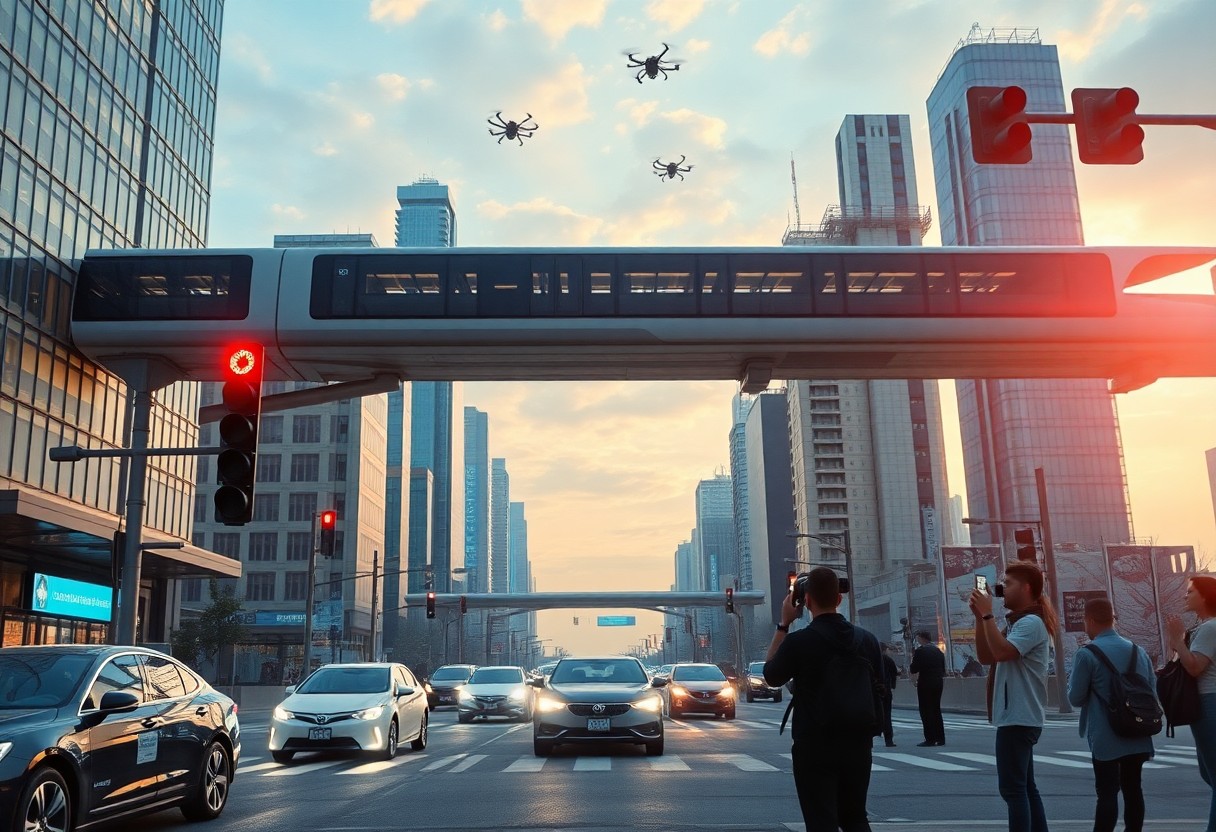Smart Technology Advancements – Redefining Transportation For Tomorrow
Quick Low-Calorie Snacks To Fuel Your Day
April 1, 2025The Ultimate Guide To Low-Calorie Ingredients For Cooking
April 2, 2025Just as you navigate through your day, smart technology advancements are transforming the way you experience transportation. These innovations promise to make travel safer, more efficient, and environmentally friendly, drastically reducing traffic congestion and emissions. Autonomous vehicles, smart traffic management systems, and connected infrastructure are not just buzzwords; they represent a shift towards a more streamlined transit experience. As you explore these exciting changes, it’s crucial to understand how they will directly affect your daily commute and travel options in the near future.
The Rise of Smart Transportation Technologies
To truly understand the future of travel, you must acknowledge the rapid evolution of smart transportation technologies. Innovations such as artificial intelligence, advanced analytics, and IoT are paving the way for safer, more efficient, and environmentally friendly travel options. With growing urbanization and the pressing need for sustainability, these technologies are set to redefine how you experience transportation in your everyday life.
Autonomous Vehicles
Against a backdrop of increasing road congestion and safety concerns, autonomous vehicles are emerging as a transformative force in transportation. These self-driving systems promise not only to reduce accidents caused by human error but also to optimize traffic flow, allowing you to enjoy a more effortless commute. The integration of advanced sensors and AI enables vehicles to navigate complex environments, making your journeys safer and more convenient.
Connected Infrastructure
At the heart of smart transportation lies connected infrastructure, designed to enhance communication between your vehicles and their surroundings. This technology enables real-time data exchange, allowing traffic signals, roadside sensors, and public transport systems to work together seamlessly. The result is a responsive transportation network that adapts to your needs, improving overall efficiency and journey times.
Hence, the implementation of connected infrastructure not only enhances safety but also leads to significant reductions in traffic congestion and lower carbon emissions. By enabling real-time communication, it allows your vehicle to anticipate traffic patterns, adjusting routes for optimal travel times. Moreover, this interconnected system can alert you to potential hazards and delays, ensuring that your travel experience is both safe and efficient. As you embrace these advancements, you can look forward to a more integrated, responsive transportation landscape that meets the demands of modern life.
Impact of AI on Transportation Efficiency
You are witnessing a transformative era in transportation, where AI technologies are enhancing efficiency across the board. With the ability to process vast amounts of data in real-time, AI optimizes routes, minimizes delays, and increases overall safety. This advancement not only saves time but also reduces fuel consumption and operational costs, paving the way for a more sustainable transportation network.
Traffic Management Systems
The integration of AI into traffic management systems has revolutionized how cities handle congestion and optimize traffic flow. By utilizing real-time data, these systems can predict peak traffic times, adjust signal timings, and even help reroute vehicles, significantly improving travel efficiency.
Predictive Analytics in Logistics
Along with optimizing traffic flow, AI employs predictive analytics in logistics to enhance shipment efficiency and reduce costs. By analyzing historical data, these systems forecast demand patterns, enabling businesses to allocate resources effectively.
Transportation networks greatly benefit from predictive analytics as they enhance operational efficiency and customer satisfaction. By utilizing historical data and real-time information, logistics companies can anticipate demand and adjust their strategies accordingly. This results in optimized routes, reduced transit times, and minimized risks of delays or shortages. Furthermore, accurate forecasting helps in maintaining inventory levels, ensuring that products are available when and where they are needed. By embracing these technologies, your logistics operations become more streamlined, ultimately leading to significant cost savings and improved service delivery.
Role of IoT in Modern Transit Solutions
Even as transportation systems evolve, the Internet of Things (IoT) plays a pivotal role in shaping modern transit solutions. By integrating smart devices, real-time data processing, and connectivity, IoT enhances the efficiency and safety of your journeys. This interconnectedness empowers transit authorities to make informed decisions, optimizes routes, and reduces delays, ultimately leading to a seamless travel experience for you.
Real-Time Monitoring and Fleet Management
Beside improving passenger safety, real-time monitoring of vehicles provides fleet managers with valuable insights into their operations. Using IoT sensors, you can track vehicle location, performance metrics, and even driver behavior. This data helps in maintaining high standards of service, while also enabling predictive maintenance to reduce unexpected breakdowns.
Smart Public Transit Systems
Before the advent of smart public transit, navigating cities could be challenging and time-consuming. However, with IoT technologies integrated into public transport, such as smart ticketing systems and live traffic updates, your travel experience has significantly improved. These advancements facilitate smoother transit operations and ensure that public transportation becomes a more attractive option for your daily commutes.
Fleet management has been transformed by IoT, ensuring that the public transit systems you rely on are not only efficient but also fully equipped to respond to various challenges. Through integrated systems, you gain access to real-time updates on bus and train arrivals, capacity levels, and route changes. This enhances your overall journey, making public transport a more reliable option. Additionally, smart infrastructure such as automated signal controls help in reducing congestion, ensuring that your time spent on the roads is minimized. With improved safety features and communication between vehicles and transit centers, you can have peace of mind traveling within these smart systems.
Sustainability and Green Technologies
Unlike traditional transportation methods that contribute significantly to pollution, sustainability and green technologies are paving the way for a cleaner, more efficient future. By prioritizing eco-friendly solutions, you can help reduce carbon footprints and promote the well-being of our planet. The integration of innovative green technologies not only supports environmental health but also enhances your urban living experience, making transportation more sustainable and accessible for everyone.
Electric and Hybrid Vehicles
Below are some of the most exciting advancements in electric and hybrid vehicles, which are transforming your daily commutes. With lower emissions and reduced reliance on fossil fuels, these vehicles are leading the charge towards a greener future. You can enjoy benefits like tax incentives, lower fueling costs, and a quieter ride, all while contributing to a more sustainable environment.
Eco-Friendly Urban Planning
Above all, effective eco-friendly urban planning is crucial for sustainable transportation. Incorporating green spaces, promoting public transit, and designing walkable cities can greatly reduce your dependence on vehicles, improving air quality and community well-being.
Consequently, implementing eco-friendly urban planning initiatives is vital for your city’s sustainability. By investing in public transportation systems, bicycle lanes, and green spaces, you will encourage healthier commuting habits while reducing traffic congestion and pollution. Prioritizing these elements fosters a sense of community, enhances the quality of life, and creates safer environments for pedestrians. Furthermore, such planning not only lowers emissions but also conserves resources, establishing a strong foundation for future urban development.

Challenges and Concerns
For the transformative advancements in smart transportation technology to succeed, you must address various challenges and concerns. Alongside the promises of efficiency and safety, you will encounter issues regarding integration, cost, and societal impact. The 7 Top Trends in Advanced Transportation Technology highlight both the potential and the hurdles that await us on this journey towards a smarter future.
Cybersecurity Risks
Below the surface of innovation lies a significant challenge: cybersecurity risks. As smart vehicles and infrastructure become interconnected, the potential for cyberattacks increases, putting not only personal data at risk but also the safety of your travel. You need to stay informed about these vulnerabilities and advocate for robust security measures to safeguard your automated travel experiences.
Regulatory and Ethical Considerations
For smart transportation to advance safely, regulatory and ethical considerations must be carefully examined. Policymakers need to establish guidelines that ensure user safety and accountability, while also promoting innovation. As new technologies emerge, you should advocate for transparency and inclusivity in regulations, ensuring that every stakeholder, including yourself, has a voice in shaping the future of transportation.
Ethical dilemmas may arise as you navigate the use of smart transportation technologies. Issues such as data privacy, the potential for discrimination in AI algorithms, and the broader implications of autonomous driving demand your attention. It’s vital to foster a dialogue about these challenges, ensuring that the benefits of innovation do not overshadow your rights and that safety remains at the forefront as transportation evolves.
Future Trends and Innovations
Despite the rapid evolution of transportation technology, the future promises even greater advancements. You can expect to see a shift towards electrification, connectivity, and automation, all of which are set to transform how you travel. Innovations in smart traffic management systems and sustainable energy solutions will enhance efficiency, reduce emissions, and reshape urban landscapes, making your journeys safer and more enjoyable.
Integration of Advanced Technologies
About the integration of advanced technologies, various systems are being employed to redefine transportation. A seamless blend of technologies ensures higher efficiency and improved safety in transportation systems:
| Connected Vehicles | Allow real-time communication with other road users. |
| AI and Machine Learning | Optimize traffic management and predictive analytics. |
| Internet of Things (IoT) | Sensors improve vehicle-to-infrastructure communication. |
| Renewable Energy | Supports sustainable transportation options. |
User Experience and Accessibility
To enhance user experience and accessibility, next-generation transportation systems will prioritize your needs. This involves implementing intuitive interfaces and ensuring mobility solutions are inclusive for all individuals, including those with disabilities. As you navigate urban spaces, expect smarter systems that cater to your requirements.
In addition, the focus on user experience revolves around creating accessible transportation options that foster independence and convenience. You may soon engage with transport services that utilize personalized apps tailored to your preferences, offering real-time updates and seamless booking. Moreover, the inclusion of multimodal transport options will provide you with greater flexibility. As improvements in technology continue, expect significant strides in ensuring safety and reducing barriers for all users, amplifying your transportation experience like never before.
Conclusion
Considering all points, it’s clear that smart technology advancements are set to significantly redefine transportation for your future. As you embrace innovations such as autonomous vehicles, real-time traffic management, and enhanced connectivity, you will experience a more efficient and sustainable travel landscape. Understanding these trends will empower you to adapt and benefit from the ever-evolving transport ecosystem, enhancing not only your commuting experience but also contributing to a smarter, greener world.
NEWSLETTER






